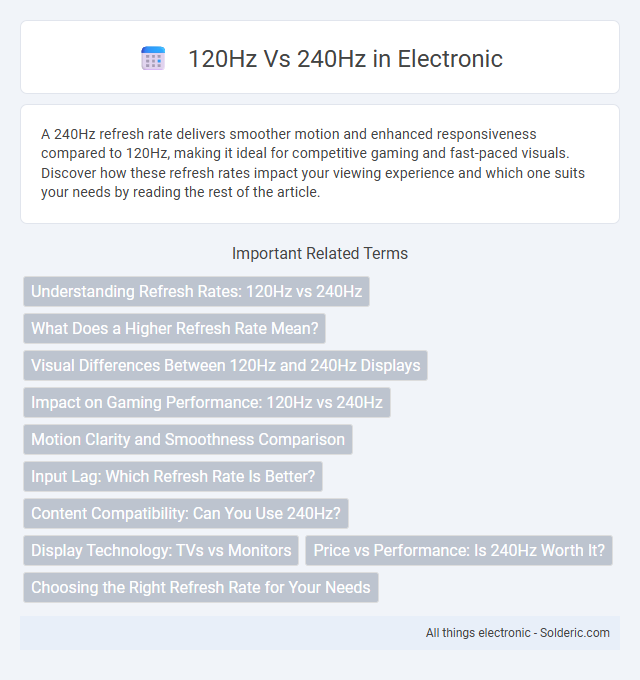A 240Hz refresh rate delivers smoother motion and enhanced responsiveness compared to 120Hz, making it ideal for competitive gaming and fast-paced visuals. Discover how these refresh rates impact your viewing experience and which one suits your needs by reading the rest of the article.
Comparison Table
| Feature | 120Hz | 240Hz |
|---|---|---|
| Refresh Rate | 120 times per second | 240 times per second |
| Smoothness | Very smooth motion | Extremely smooth motion, ideal for fast-paced content |
| Response Time | Good for casual and competitive gaming | Better response for professional and high-level gaming |
| Hardware Demand | Moderate GPU/CPU load | High GPU/CPU load required |
| Battery Usage (Mobile) | Lower battery consumption | Higher battery consumption |
| Price | More affordable | Usually more expensive |
| Ideal Use | General gaming, video playback, and everyday use | Competitive esports and fast reaction gaming |
Understanding Refresh Rates: 120Hz vs 240Hz
A 120Hz refresh rate refreshes the screen 120 times per second, providing smoother motion and reduced motion blur compared to standard 60Hz displays, ideal for gaming and fast-paced content. A 240Hz refresh rate doubles this to 240 refreshes per second, offering even more fluid visuals and enhanced responsiveness, particularly beneficial for competitive gamers seeking ultra-fast reaction times. However, the perceptible difference between 120Hz and 240Hz depends on the content type, hardware capabilities, and individual sensitivity to refresh rate changes.
What Does a Higher Refresh Rate Mean?
A higher refresh rate, such as 240Hz compared to 120Hz, means the display updates images more frequently per second, resulting in smoother motion and reduced motion blur. This is particularly beneficial for fast-paced gaming and action-packed visuals, where every millisecond counts for responsiveness and clarity. Increased refresh rates also decrease input lag, providing a more fluid and immersive viewing experience.
Visual Differences Between 120Hz and 240Hz Displays
120Hz displays refresh the screen 120 times per second, providing smoother motion than standard 60Hz panels, while 240Hz screens double that rate to 240 updates per second, resulting in even more fluid visuals. The difference between 120Hz and 240Hz becomes noticeable in fast-paced environments like gaming and high-speed video playback, where 240Hz offers reduced motion blur and sharper image transitions. However, the perceptible improvement depends on the viewer's sensitivity to motion and the content's frame rate compatibility with such high refresh rates.
Impact on Gaming Performance: 120Hz vs 240Hz
A 240Hz refresh rate offers smoother motion and reduced input lag compared to 120Hz, significantly enhancing gaming performance in fast-paced competitive titles such as first-person shooters and racing games. Gamers utilizing a 240Hz display experience more precise visual tracking, leading to quicker reaction times and improved accuracy in-game. However, the performance gains are most noticeable with high-end GPUs and are less impactful on casual or single-player games where frame rates rarely exceed 120fps.
Motion Clarity and Smoothness Comparison
A 240Hz refresh rate offers significantly enhanced motion clarity and smoothness compared to 120Hz, especially in fast-paced gaming and high-speed video content. This higher refresh rate reduces motion blur and screen tearing, providing a more fluid visual experience that helps You track moving objects with greater precision. While 120Hz is already a major improvement over standard 60Hz displays, 240Hz delivers the ultimate performance for competitive gamers and users seeking ultra-smooth visuals.
Input Lag: Which Refresh Rate Is Better?
A 240Hz refresh rate typically results in lower input lag compared to 120Hz, providing faster and more responsive interactions that benefit competitive gaming. Your device's performance depends on its ability to match higher refresh rates; without optimized hardware, the difference in input lag may be negligible. Choosing 240Hz can improve reaction times in fast-paced scenarios, but your overall experience also depends on factors like display quality and graphics processing.
Content Compatibility: Can You Use 240Hz?
240Hz displays offer smoother motion ideal for fast-paced gaming and high-frame-rate content, but compatibility depends on both the source device and the content itself. Most standard videos and many games are capped at 60-120fps, meaning a 240Hz monitor will often rely on frame interpolation or duplicate frames when true 240fps content isn't available. To fully utilize 240Hz, ensure your GPU and game settings support frame rates near 240fps, while streaming and video content generally remain optimized for 60Hz to 120Hz playback.
Display Technology: TVs vs Monitors
TVs with 120Hz refresh rates typically use advanced display technologies like OLED or QLED, offering smoother motion for fast-paced video content and gaming. Monitors with 240Hz refresh rates often employ TN or IPS panels optimized for competitive gaming, delivering ultra-responsive visuals and reduced input lag essential for professional eSports performance. The choice between 120Hz TVs and 240Hz monitors hinges on usage scenarios, with TVs excelling in cinematic quality and monitors prioritizing speed and precision.
Price vs Performance: Is 240Hz Worth It?
240Hz monitors offer smoother motion and reduced blur compared to 120Hz, making them ideal for competitive gamers seeking every advantage in fast-paced scenes. However, the price difference between 120Hz and 240Hz displays can be significant, and the performance gain may not be as noticeable if your hardware or games don't fully support ultra-high frame rates. Your decision should weigh whether the premium cost aligns with your gaming needs and current system capabilities to justify investing in 240Hz technology.
Choosing the Right Refresh Rate for Your Needs
A 120Hz refresh rate provides smooth visuals ideal for everyday gaming, video watching, and general use, offering a balance between performance and power consumption. A 240Hz refresh rate caters to competitive gamers seeking ultra-responsive and fluid motion, enhancing reaction times in fast-paced scenarios. Consider your gaming style and hardware capabilities to choose the refresh rate that optimally matches your performance needs and visual experience.
120Hz vs 240Hz Infographic

 solderic.com
solderic.com